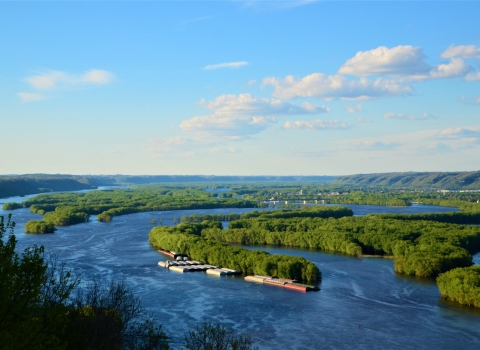The U.S. Fish and Wildlife Service announced today the availability of the draft recovery plan for the endangered whorled sunflower, providing an opportunity for the public to review and comment during the recovery plan’s development.
Close collaboration with our partners, the public, Federal, State, and local government agencies is required for the whorled sunflower’s recovery. The Service is seeking additional information regarding threats to the species, ongoing beneficial management efforts and costs associated with implementing the plan.
The whorled sunflower (Helianthus verticillatus) is an herbaceous, flowering plant first described in 1898 based off a collection from Chester County, Tennessee. Of the nine known historic populations in Alabama, Georgia, Mississippi, Tennessee, and Virginia, it is extant in eight.
It was federally listed as endangered in August 2014 with designated critical habitat in Alabama, Georgia, and Tennessee. Populations in Mississippi and Virginia were not known at the time of the critical habitat designation.
The objectives of the draft recovery plan are to protect, restore, and manage habitat to provide the conditions for the species to recover and ultimately remove it from the List of Endangered and Threatened Plants.
Whorled sunflower is assigned a recovery priority number of five, which indicates the species faces a high degree of threat with low recovery potential.
The threats to whorled sunflower are threats to a unique part of the natural heritage of its current and historic range. The greatest threats are loss or degradation of habitat and problems inherent in small, isolated populations.
Whorled sunflower is dependent upon remnant prairies, prairie-like habitats, and open woodlands for survival. The main causes of habitat degradation or loss are incompatible mechanical and chemical vegetation management for industrial forestry, right-of-way maintenance, and agriculture and shading and competition from successional vegetation.
Small, isolated populations have fewer compatible mates. This increases inbreeding which could lead to reduced seed production and viability, making the plant less likely to recover from habitat loss or degradation.
Climate change has the potential to affect distribution and abundance of plants by influencing seasonal weather patterns, frequency and timing of severe weather events, species interactions, and plant physiological responses.
The draft recovery plan will be made available at https://ecos.fws.gov/ecp/species/3375. To obtain a copy by mail, send a request to U.S. Fish and Wildlife Service, Mississippi Ecological Services Field Office, 6578 Dogwood View Parkway, Suite A, Jackson, MS 39214-7856 or by phone: 601-695-4900.
To ensure consideration, the Service must receive written comments on or before August 8, 2022. However, the Service will accept information about any species at any time.
Submit comments in writing to Mississippi_field_office@fws.gov or by mail to the Mississippi Ecological Services Field Office.
The mission of the U.S. Fish and Wildlife Service is working with others to conserve, protect, and enhance fish, wildlife, plants, and their habitats for the continuing benefit of the American people. For more information on our work and the people who make it happen, visit www.fws.gov/southeast. Connect with us on Facebook at www.facebook.com/usfwssoutheast, follow our tweets at www.twitter.com/usfwssoutheast, watch our YouTube Channel at http://www.youtube.com/usfws, and download photos from our Flickr page at http://www.flickr.com/photos/usfwssoutheast.


